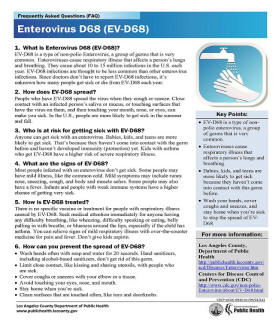Enterovirus

Enteroviruses were originally classified into four
groups: polioviruses, Coxsackie A viruses (CA),
Coxsackie B viruses (CB), and echoviruses. Poliovirus is
responsible for the disease polio which invades the
nervous system and can cause severe disease including
paralysis or death. Because of vaccination efforts,
polio has been eradicated from the US. There have been
no cases of polio contracted in the US since 1979, but
polio is still a threat in other countries. Non-polio
enteroviruses are very common and cause cold-like
symptoms. There are over 60 non-polio enteroviruses that
are known to cause disease in humans. Illness from
enteroviruses is usually mild and occurs mostly during
the summer and fall. Infants and children are more
likely to become sick since they lack the immunity from
previous exposures that adults have. Neonates are at
higher risk for severe illness because of the immaturity
of their immune systems. These viruses usually spread
from infected personís bodily fluids (snot and spit) or
by touching objects and surfaces that have the virus on
them. For health care facilities, infection control
should include standard, contact, and droplet
precautions.
Although individual cases of enterovirus are not
reportable, physicians who see an unusual increase in
the number of acute respiratory illness among their
patients should report this to ACDC:
-
On weekdays, between 8:00 am-5:00 pm,
call the Acute Communicable Disease
Control Program at (213) 240-7941.
-
During
non-business hours (before 8:00 am,
after 5:00 pm, or weekends), call the
Los Angeles County Operator at (213)
974-1234 and ask for the Public Health
doctor on-call.
Enterovirus D68 Frequently Asked Questions (FAQ) Sheet
English
Spanish

Resources:

